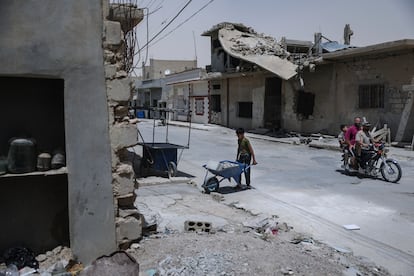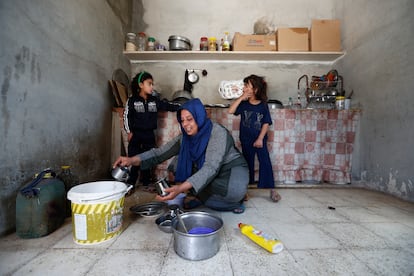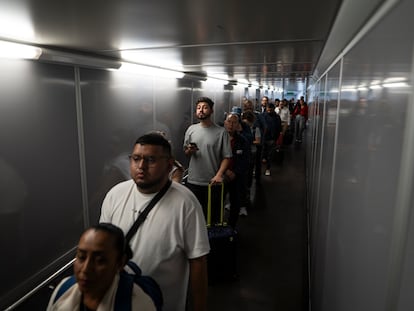The number of displaced people in the world is growing at a slower pace due to voluntary returns and deportations
Some 123.2 million people were living as refugees in 2024, double the number a decade ago, but UNHCR has noted a slight change in the trend in recent months

Some Arab media outlets reported an unusual piece of news a few days ago: the closure of a refugee camp in Rukban, a Jordanian town very close to the Syrian border, where up to 100,000 people were once eking out a living in what the new Syrian government’s Information Minister, Hamza Almustafa, described as “a triangle of death that bore witness to the cruelty of siege and hunger.”
The closure of this settlement has not only meant freedom for thousands of Syrians: it also represents one of the realities that describe the current situation of displaced people around the world. For the first time in more than a decade, the increase in the number of those forced to flee their homes has slowed down. It was only 1% between January and April 2025, which is the extent of the latest data from the UN High Commissioner for Refugees (UNHCR), which on Thursday publishes its annual report on displacement. The number marks the first change in a trend that always breaks records. The main reason: refugees’ return to their countries of origin.
Far from considering this good news, UNHCR points out that nothing should overshadow the “unacceptable” fact that 2024 saw a new record in the number of displaced people and refugees worldwide: 123.2 million, twice the number seen a decade ago and 6% more than in 2023, although last April the overall figure had been reduced to 122.1 million due to this change in trend. Furthermore, the decrease was only recorded among the refugee population, as internally displaced persons—those who have to flee their homes but do not cross their country’s borders—did increase, reaching 73.5 million at the end of 2024.
UNHCR spokesperson in Spain, Paula Barrachina, warns that we must not overlook the other side of the story: “The decrease is partly explained by the fact that last year, 1.9 million people either returned to their place of origin, were resettled in a third country, or obtained permanent residency in the host country. They are no longer counted as refugees, but each situation must be distinguished; a voluntary return like the recent ones in Syria is not the same as what is happening with Afghans in Pakistan and Iran, which is neither voluntary, nor dignified, nor lasting,” she denounces.
Barrachina is referring to the decision by the governments of both countries to return Afghan refugees, nearly 10 million of whom are outside their country: 780,000 Afghans have returned so far this year, but at least 351,000 were forcibly deported, according to UNHCR data.
The expert explains that the forecasts are based on the evolution of current armed conflicts, as these and the string of violence they entail are the main causes of forced population displacement. The war in Sudan, the Russian invasion of Ukraine, terrorism in the Sahel, and the Israeli offensive in Gaza are the main causes.
According to the Thursday report, what happens during the remainder of 2025 will depend on the dynamics of several key situations. This includes whether peace can be achieved, or at least a cessation of fighting, particularly in the Democratic Republic of the Congo, Sudan and Ukraine; whether the situation in South Sudan deteriorates further; whether conditions for return improve, particularly in Afghanistan and Syria; and how severe the impact of current funding cuts will be on the capacity to address forced displacement situations around the world. Barrachina gives an insight into the situation: “We have twice as many refugees as a decade ago, but UNHCR has almost the same funding as then.”
The European Union and United States’ migrant and refugee reception policies could also be a lifeline or a death sentence for millions of people. The Donald Trump administration did not provide data for the last half of 2024, so UNHCR only has information up to July of that year on what’s happening in the U.S. and has been unable to assess whether the policies of the new president have had any impact.
The U.S. receives the most asylum applications
But the tightening of raids against migrants, including asylum seekers, and the increase in forced deportations since the Republican took office last January could influence the continuation of the downward trend in refugee numbers. For now, the global resettlement program, which last year achieved a record number of 188,000 resettled people (the highest number in 40 years, according to UNHCR), has been practically extinguished following the exit of the U.S., a country that, incidentally, receives the most asylum applications: 729,100 in 2024.
Also of influence are the future decisions of the European Union and its Member States, many of which have new governments inclined to toughen their migration and asylum policies. According to the European Union’s statistical office (Eurostat), 939,985 decisions on asylum applications were issued last year in EU, granting protection status to a total of 437,900 individuals. The majority were Syrians, Afghans and Venezuelans. This is the highest figure since 2017, but still less than half of those who applied were granted asylum.
The case of Syria
Yasmine al-Saleh is one of the Syrian citizens who survived Rukban. She spent nine years there and gave birth to her two daughters. Although her home in Al Qaryatayn, in the eastern Syrian province of Homs, has suffered damage during her absence, she says her happiness is indescribable. “Even though our house is destroyed, we have no money, we are hungry, we are in debt, my husband is old and can’t work, and I have children, it’s still a castle in the air,” she tearfully told an Associated Press reporter last week.
In Al Saleh’s case, the reading is positive: some returns are due to the fact that more people have been able to go home voluntarily because the reasons that led them to flee have disappeared. And here the clearest example is Syria, where the fall of Bashar al-Assad’s regime last December, after 14 years of war, has encouraged 13.8 million citizens to return to their country.

However, this incipient return—1.4 million people, according to the International Organization for Migration (IOM)—does not mean that the problems have been solved. UNHCR insists that it is premature to even consider withdrawing the protection granted to Syrian refugees or freezing their applications, as Germany, France, the United Kingdom, and other European countries already attempted to do days after the overthrow of the Syrian dictator.
“Syria needs almost complete reconstruction. We are asking the countries hosting Syrian refugees to maintain their protection because Syria is not yet in a position to receive all of its refugees back,” Barrachina argues.
A gap of a million people
Barrachina also lists a number of other reasons for this possible decrease in the number of refugees. “We are experiencing a very delicate time for humanitarian actors and displaced people. There is a great deal of political volatility and, at the same time, a multitude of conflicts for which several actors should be able to agree on solutions, but are not doing so, coupled with an alarming decrease in humanitarian aid funding,” says the UNHCR spokesperson.
The lack of data in some countries—not just the U.S., but also Russia, among others—leads them to believe that there may be around one million more displaced persons and refugees worldwide than are currently known. The highly volatile movements of the internally displaced population also play a role.
In Sudan, the country with the world’s largest refugee crisis (nearly 12 million people displaced from their homes), there was a significant return in late 2024 as the situation calmed down somewhat, but the upsurge in violence in Darfur at the beginning of the year again triggered a mass exodus.
Sign up for our weekly newsletter to get more English-language news coverage from EL PAÍS USA Edition
Tu suscripción se está usando en otro dispositivo
¿Quieres añadir otro usuario a tu suscripción?
Si continúas leyendo en este dispositivo, no se podrá leer en el otro.
FlechaTu suscripción se está usando en otro dispositivo y solo puedes acceder a EL PAÍS desde un dispositivo a la vez.
Si quieres compartir tu cuenta, cambia tu suscripción a la modalidad Premium, así podrás añadir otro usuario. Cada uno accederá con su propia cuenta de email, lo que os permitirá personalizar vuestra experiencia en EL PAÍS.
¿Tienes una suscripción de empresa? Accede aquí para contratar más cuentas.
En el caso de no saber quién está usando tu cuenta, te recomendamos cambiar tu contraseña aquí.
Si decides continuar compartiendo tu cuenta, este mensaje se mostrará en tu dispositivo y en el de la otra persona que está usando tu cuenta de forma indefinida, afectando a tu experiencia de lectura. Puedes consultar aquí los términos y condiciones de la suscripción digital.
More information
Archived In
Últimas noticias
ICE raids trigger school absenteeism and traumatize children: ‘They have been forced to leave their childhood behind’
The guardians of the meteorites of the Argentine Chaco
Helen Levitt, the photographer who captured the theater of the everyday
The life of a delivery driver in China: ‘Many people don’t know how an order can arrive at their home in just one day’
Most viewed
- Christian Louboutin: ‘Young people don’t want to be like their parents. And if their parents wear sneakers, they’re going to look for something else’
- US sanctions against jailed cartel leader ‘El Marro’ highlight Mexico’s lack of control over its prisons
- The low-cost creative revolution: How technology is making art accessible to everyone
- Liset Menéndez de la Prida, neuroscientist: ‘It’s not normal to constantly seek pleasure; it’s important to be bored, to be calm’
- Cartels in Mexico take a leap forward with narco-drones: ‘It is criminal groups that are leading the innovation race’











































